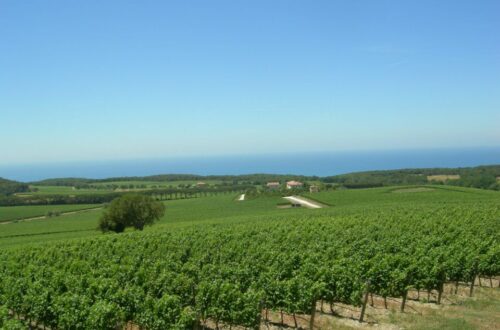Table of Contents
What Is Vin Santo del Chianti Classico DOC?
Vin Santo del Chianti Classico DOC is Tuscany’s storied “holy wine,” a luxurious dessert wine produced via appassimento, where grapes are air-dried to concentrate sugars before fermenting and aging. Known for its golden hues, nutty flavors, and delicate sweetness, this Italian dessert wine is a cherished tradition of Chianti Classico and Italy’s rich wine culture. Wikipediachianti-classico.guides.winefolly.comWine Folly
Vin Santo’s Origins & DOC Recognition
Dating back to medieval hospitality and monastic rituals, Vin Santo evolved from humble tavern fare to refined elixir. Recognized as a DOC in 1995, Vin Santo del Chianti Classico stands as a testament to centuries of winemaking heritage.Wine Scholar GuildWikipedia
Chianti Classico Terroir
Crafted in the classic wine heartland between Florence and Siena, this DOC thrives on clayey-limestone soils, warm sun-soaked days, and cool Tuscan nights—ideal conditions for drying and flavor concentration.Visit Tuscany
Vin Santo Grape Varieties
The foundation is typically Trebbiano Toscano and Malvasia Bianca Lunga, though the Occhio di Pernice version features ≥80% Sangiovese, offering rosé-like hues and red-fruited complexity.WikipediaWikipedia
Vin Santo Production & DOC Rules
- Appassimento Method: Grapes dried until sugar levels reach ~26% (Trebbiano/Malvasia) or ~27% (Occhio di Pernice).Wikipedia+1
- Aging: Minimum 3 years (Riserva: 4 years), with label release starting November of the third year.Wikipedia
- Styles: Sweetness levels include Secco, Abboccato, Amabile, Dolce; Occhio di Pernice denotes red-tinged version.Wikipedia
Key Facts at a Glance
| Feature | Details |
| Region | Chianti Classico, Tuscany |
| Grapes | Trebbiano, Malvasia; Sangiovese for Occhio di Pernice |
| Method | Appassimento + extended aging |
| Aging | ≥ 3 years in caratelli, then bottle |
| Styles | Secco, Occhio di Pernice, etc. |
| Price Range | €25–€40; Premium or aged bottles may be more |
Vin Santo Tasting Profiles
- Classic Style: Amber with aromas of dried apricot, honey, almond, spice; velvety, balanced sweetness.Wilson Danielschianti-classico.guides.winefolly.com
- Occhio di Pernice: Deep garnet; aromas of jammy red fruit, rose, spices, dried cherry, with a plush, rich palate.Wikipedia
Serving Tips & Food Pairings
- Temperature: 12–16 °C in a small wine glass.
- Pair beautifully with almond cantucci, blue cheeses, baklava, fruit tarts. Particularly elegant, meditative sipper.chianti-classico.guides.winefolly.comFood & Wine
Buying Guide & Pricing
Produced on approximately 33 hectares, with limited production and high artisanal value. Look for bottles priced between €25–€40, with higher prices for Riserva and vintage selections, available through Italian wine shops and importers.Italian Wine Central
Frequently Asked Questions
Is Vin Santo fortified?
No; its sweetness comes from dried grapes and natural fermentation.WikipediaWine4Food
How long does it last?
Classic styles age gracefully over many years; Occhio di Pernice and Riserva may age a decade or more.
Cultural Significance & Fun Facts
- Named “holy wine” due to its role in religious rituals and Sunday feasts.Wine4Food
- Deeply tied to Tuscan hospitality and family traditions, often enjoyed with almond cantucci.
- The aging process in small caratelli barrels creates the rich oxidative character that defines its style.Wine Scholar Guild
Top Producers to Explore
- Lamole di Lamole – distinctive terraced vineyards, rich texture.
- Avignonesi – famous for masterful aging and balance.Food & Wine
- Other notable names: Castello di Volpaia, Felsina, Antinori, Capezzana.
Vin Santo vs Passito Comparison
| Wine Type | Vin Santo (Tuscany) | Passito (e.g., Pantelleria) |
| Grape Base | Trebbiano, Malvasia (Sangiovese in Occhio di Pernice) | Muscat or regional white varieties |
| Drying Method | Straw mats or racks indoors | Sun-drying or indoor methods |
| Typical Flavor | Nutty, honeyed, spice layers | Fruit-forward, floral, baklava-like |
| Style Variation | Multiple sweetness levels | Often intensely swe |
Call to Action
Let Vin Santo whisper Tuscany’s ancient story into your glass. Find a bottle of Vin Santo del Chianti Classico DOC near you or plan a tasting journey through Chianti Classico. Share your moments with #DrinkItalianVinSanto and join our global community of cultural wine lovers.


